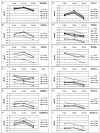Assessment of hearing in 80 inbred strains of mice by ABR threshold analyses
- PMID: 10320101
- PMCID: PMC2855304
- DOI: 10.1016/s0378-5955(99)00003-9
Assessment of hearing in 80 inbred strains of mice by ABR threshold analyses
Abstract
The common occurrence of hearing loss in both humans and mice, and the anatomical and functional similarities of their inner ears, attest to the potential of mice being used as models to study inherited hearing loss. A large-scale, auditory screening project is being undertaken at The Jackson Laboratory (TJL) to identify mice with inherited hearing disorders. To assess hearing sensitivity, at least five mice from each inbred strain had auditory brainstem response (ABR) thresholds determined. Thus far, we have screened 80 inbred strains of mice; 60 of them exhibited homogeneous ABR threshold values not significantly different from those of the control strain CBA/CaJ. This large database establishes a reliable reference for normal hearing mouse strains. The following 16 inbred strains exhibited significantly elevated ABR thresholds before the age of 3 months: 129/J, 129/ReJ, 129/SvJ, A/J, ALR/LtJ, ALS/LtJ, BUB/BnJ, C57BLKS/J, C57BR/cdJ, C57L/J, DBA/2J, I/LnJ, MA/MyJ, NOD/LtJ, NOR/LtJ, and SKH2/J. These hearing impaired strains may serve as models for some forms of human non-syndromic hearing loss and aid in the identification of the underlying genes.
Figures


Similar articles
-
A comparison of vestibular and auditory phenotypes in inbred mouse strains.Brain Res. 2006 May 26;1091(1):40-6. doi: 10.1016/j.brainres.2006.01.066. Epub 2006 Feb 24. Brain Res. 2006. PMID: 16499890 Free PMC article.
-
Hearing loss associated with the modifier of deaf waddler (mdfw) locus corresponds with age-related hearing loss in 12 inbred strains of mice.Hear Res. 2001 Apr;154(1-2):45-53. doi: 10.1016/s0378-5955(01)00215-5. Hear Res. 2001. PMID: 11423214 Free PMC article.
-
Characterization of the early pathology of cochlear stereocilia in four inbred mouse strains with progressive hearing loss.Histol Histopathol. 2019 Jul;34(7):811-820. doi: 10.14670/HH-18-086. Epub 2019 Jan 24. Histol Histopathol. 2019. PMID: 30675896
-
[Electrophysiologic hearing evaluation in childhood--a critical assessment].Eur Arch Otorhinolaryngol Suppl. 1994;1:129-48. Eur Arch Otorhinolaryngol Suppl. 1994. PMID: 8012235 Review. German. No abstract available.
-
The auditory brainstem response in pediatrics.Otolaryngol Clin North Am. 1989 Jun;22(3):473-500. Otolaryngol Clin North Am. 1989. PMID: 2657580 Review.
Cited by
-
Hearing loss and hair cell death in mice given the cholesterol-chelating agent hydroxypropyl-β-cyclodextrin.PLoS One. 2012;7(12):e53280. doi: 10.1371/journal.pone.0053280. Epub 2012 Dec 28. PLoS One. 2012. PMID: 23285273 Free PMC article.
-
An Age-Related Hearing Protection Locus on Chromosome 16 of BXD Strain Mice.Neural Plast. 2020 Jun 8;2020:8889264. doi: 10.1155/2020/8889264. eCollection 2020. Neural Plast. 2020. PMID: 32587610 Free PMC article.
-
The Time Course of Deafness and Retinal Degeneration in a Kunming Mouse Model for Usher Syndrome.PLoS One. 2016 May 17;11(5):e0155619. doi: 10.1371/journal.pone.0155619. eCollection 2016. PLoS One. 2016. PMID: 27186975 Free PMC article.
-
A hypomorphic mutation of the gamma-1 adaptin gene (Ap1g1) causes inner ear, retina, thyroid, and testes abnormalities in mice.Mamm Genome. 2016 Jun;27(5-6):200-12. doi: 10.1007/s00335-016-9632-0. Epub 2016 Apr 18. Mamm Genome. 2016. PMID: 27090238 Free PMC article.
-
Deafness in Claudin 11-null mice reveals the critical contribution of basal cell tight junctions to stria vascularis function.J Neurosci. 2004 Aug 11;24(32):7051-62. doi: 10.1523/JNEUROSCI.1640-04.2004. J Neurosci. 2004. PMID: 15306639 Free PMC article.
References
-
- Atchley WR, Fitch W. Genetic affinities of inbred mouse strains of uncertain origin. Mol. Biol. Evol. 1993;10:1150–1169. - PubMed
-
- Brown SD, Steel KP. Genetic deafness – progress with mouse models. Hum. Mol. Genet. 1994;3(Spec. No):1453–1546. - PubMed
-
- Church MW, Shucard DW. Age-related hearing loss in BDF1 mice as evidenced by the brainstem auditory evoked potential. Audiology. 1986;25:363–372. - PubMed
-
- Deol MS. A gene for uncomplicated deafness in the mouse. J. Embryol. Exp. Morphol. 1956;4:190–195.
-
- Ehret G. Psychoacoustics. In: Willot JF, editor. Auditory Psychobiology of the Mouse. Charles C. Thomas; Springfield, IL: 1983. pp. 13–53.
Publication types
MeSH terms
Grants and funding
LinkOut - more resources
Full Text Sources
Other Literature Sources
Medical
Molecular Biology Databases
Miscellaneous

